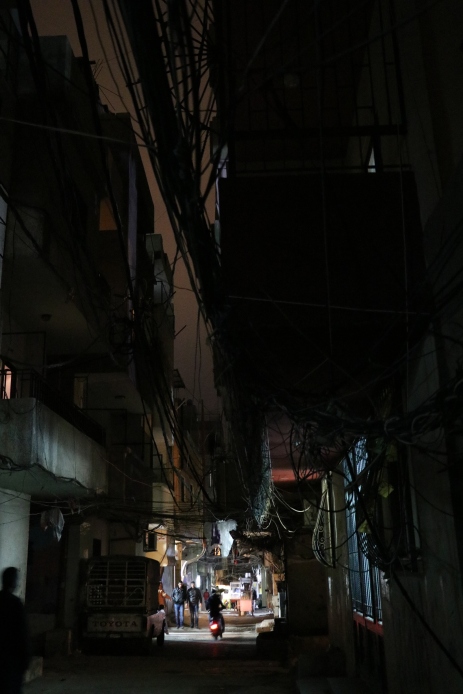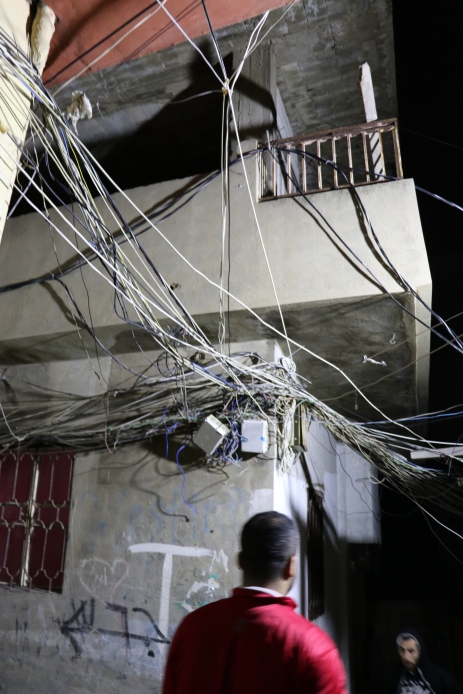by Dr. Elena Fiddian-Qasmiyeh, UCL and PI of Refugee Hosts
Invisible (at) night: space, time and photography in a refugee camp
If our perceptions of refugees’ experiences of displacement were based on photographs produced and disseminated by the UN, NGOs and the media, we could be forgiven for assuming that refugees’ daytimes are either seemingly eternal or that night-time merely exists for sleeping. However, photographers capture the spaces and times where/when humanitarian officials, journalists and academics (typically non-refugees) have visited a given refugee context, rather than the spaces and times inhabited – day and night and everything in between -, by diverse groups of refugees and hosts.
Many – or perhaps most – external visitors to the spaces inhabited by refugees in camps and cities arrive after dawn and depart before dusk, with their cameras’ lenses capturing refugees’ day-time endeavours and activities in a selective way (as also noted by Vogler here).
Whether for reasons of safety or comfort, due to official restrictions or personal decisions, visitors and their cameras may remain during daylight hours, but then typically return to their own temporary or permanent homes elsewhere, withdrawing their gaze from the diverse spaces inhabited by refugees.
And yet these spaces, and their inhabitants, not only remain after dusk, but come to life in different ways.
As I look back at the photographs I have published on Refugee Hosts of the last four fieldtrips I have made to the urban Baddawi Palestinian refugee camp in North Lebanon between 2015 and 2017 – when I resided in the camp for several weeks at a time -, I found a preponderance of images depicting diverse spaces and people under the sun and in daylight shadows and shade, with only a handful of evening and sunset photographs (i.e. see here and here).
Some photographs were taken at night, but the viewer may not have known this, as they are images I took indoors under artificial light. As a research project aiming to explore the ‘everyday’ spaces of encounter between refugees from Syria and their diverse hosting communities – in this case, established Palestinian refugees in Baddawi camp – my photo-essays seem, so far, to have centralised representations of ‘the day’ to the detriment of the diverse temporalities of these encounters and spaces.
Over the course of this and another short photo-essay, I purposefully include night-time images of the camp’s alleyways, cemetery and skyline, as a means of taking a few further steps towards reflecting on the invisibility of the night and refugees’ (in)visibility at night in this and other refugee contexts.
Part of this reflection is offered as a means of highlighting the extent to which certain facets of refugees’ lives, and indeed certain refugees, can become invisible through this tendency to photograph during the daytime. However, it also opens up – or requires – a space to acknowledge the decisions – including aesthetic ones – which may consciously or unconsciously drive the framing and dissemination of particular depictions of certain people and spaces while others remain, or are rendered, invisible.
*
Part One – Arriving in Baddawi: a night-time view
This first photo-essay traces the steps one might take – whether as a visitor, long-time resident, or new arrival – when entering and walking through Baddawi refugee camp in the evening and night. The photographs were taken on a series of ‘walking tours’ I took with different people in and around the camp, in which I follow the steps of camp residents to enter the camp, walking through alleyways which are variously dark or brightly lit, traverse the camp’s original cemetery, and pass shops whose owners’ relatives – I am told – have lost their lives whilst trying to reach Europe.
While I was often invited to photograph these and other people during my walks, here, as elsewhere on our blog and in our Refugee Hosts project more broadly, I have consciously decided not to place individual people’s faces on display. Rather, through these photos I aim to invite the reader/viewer to consider the dynamics – social, economic, religious, political, historical and contemporary – which have created and continue to create these spaces of encounter between different groups of hosts and refugees. This is one of the decisions – which may itself be contested and challenged on different levels – which guides our project, and is explored through this new blog series on ‘Representations of [everyday life in] Displacement’.
‘Nobody knows for certain where the camp’s entrance is’ – Yousif M. Qasmiyeh
As this first series of photographs depicts, the contours of where the camp begins and ends are both clear and blurred – the electricity generator, with a Palestinian flag waving above it, is both of the camp and for the camp, and yet is not ‘in’ the camp’s officially designated territory. The generator is situated outside Baddawi’s narrow alleyways which separate the buildings constructed upon land leased by UNRWA for Palestinian refugees’ ‘usage’. Equally, the shops and houses on the borders of the camp –run by Palestinians, Lebanese, Iraqis – cater to refugees and non-refugees who live inside and outside of that space; and the cars parked in what initially appears as a ‘cul-de-sac’ upon arrival belong to people of diverse nationalities, legal statuses and none. The apparent ‘cul-de-sac’ itself does not only not lead to an ‘end’ but rather to multiple beginnings of and entrances to the camp.















*
Read Part Two, ‘Shadows and/or Echoes of Displacement’, here
See our new blog series for other reflections and pieces on Representations and Displacement.
Featured image: Walking at night in Baddawi camp. (c) E. Fiddian-Qasmiyeh. Jan. 2017

10 comments